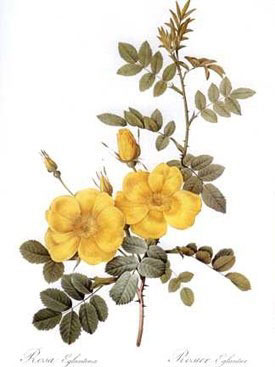All over the West, roses survive without care wherever they were planted, some more than a century ago. How did they come to such hardscrabble places? How did the old homesteads and cemeteries come to be graced with plants that had little value beyond the aesthetic?
The earliest way they came was in covered wagons – accompanying settlers uprooted from eastern homes, friends and families – carefully nurtured across forests, plains, mountains and deserts. Kim Rupert put it so well: "You always took pieces of your garden with you when you moved, particularly those 'remembrance' plants: as evidenced by Rosa foetida and 'Harison's Yellow' following both the Oregon and Mormon Trails across the country." Possibly others were planted along the way, but these two varieties endured, having the capability to thrive in dry climates, even with total neglect.

Rosa foetida - (Redoute's Roses).
Roses came not only overland from the eastern portions of the continent, by ships crossing both oceans, Spanish, Russian and Chinese immigrants brought plants with them. Chinese roses were undoubtedly also brought from the Orient by sea captains, as gifts for friends or to sell to avid plant collectors. New French and British roses were often featured in the catalogues of local nurseries within months of their European introduction dates.
While Californians were not adverse to ordering from eastern nurseries or even importing from overseas sources, travel was slow and uncertain; plants were too often found to be dead on arrival. Soon after gold was discovered in California, there was a rush of entrepreneurs seeking to make their fortunes by providing supplies to the Gold Rush miners. By 1850, a nurseryman named Anthony Preston Smith had already established himself just east of the town of Sacramento. Originally from upstate New York, he joined a group of 30 men who pooled their resources to buy a boat and sail for the gold fields via Cape Horn. He was a gambler, and by the time the boat arrived in Sacramento, Smith had won a sixth of the total resources in the pool, arriving already a wealthy man. He purchased 50 acres from Captain John Sutter, paying $100 per acre; this nursery was located just north of where Sacramento State University is today, on the south bank of the American River.
The soil was rich, and by 1852 Smith's gardens were producing seed, flowers, shrubs and trees for sale. By 1855 fresh fruit from his orchards and vineyards produced a substantial profit. The first California raisons were grown there. Smith's home was built among the orchards and greenhouses. By 1858 the gardens were much larger and included 11,000 young fruit trees as well as nut, ornamental and timber trees.
Smith's Pleasure Gardens (sometimes called Smith's Pomological Gardens) became a destination for day excursions. Paths were paved with broken shells gathered from coastal Indian maidens; the landscaping of flowers and trees made strolling pleasurable in a city that as yet had no municipal parks. Smith employed 30 workers, including Thomas O'Brian from Philadelphia, who was his rose and flower specialist. It was O'Brian who laid out the walks and planted the flowers. There were 15,000 roses and 2,000 camellias, in addition to flower and vegetable plants raised from seed. O'Brian remained with Smith from 1050 to 1854, before starting his own Sacramento establishment, the Rosedale Nursery. By then, sever other nurseries and florists had also set up business in the area, and others were moving into the more populated towns of the state such as San Francisco and San Jose. Wagons from Sacramento went out weekly to surrounding communities, delivering goods and plants.
Smith's catalog for 1856-7 listed 31 Hybrid Perpetuals, 11 Bourbons, 7 China or Bengal Roes, 9 Noissettes, 10 Tea-Scented Roses, 7 Moss Roses, and 8 Climbing Roses for sale. In 1855, he was offered $75,000 for his Gardens, which he refused, estimating the property was worth fully $100,000. This proved to be a most unfortunate decision.
Hydraulic mining in the mountains speeded the drainage of rain and snowmelt water to the rivers; deposits of hydraulic debris reduced the depth of both the Sacramento and American Rivers and, subsequently, raised the water levels as well. The flood of 181, followed by the still greater flood of 1862, burst the levee to the north of Smith's land, sweeping away the labor of years – the beautiful gardens, the popular pleasure resort, his house and outbuildings. Six feet of silt covered the gardens. Smith attempted to rebuild, but in 1871, another great flood swept over the remains of the Gardens.
Smith died in 1877 – but the heritage of his vision remains. In Sacramento, called both the 'City of Trees' and also the 'Camilia Capitol', numerous roses have been found in cemeteries, pastures and old home sites. Others have been found in nearby Northern California towns. These have all been colleted together at the Historic Rose Garden planted in the Old Sacramento Cemetery, flourishing as a memento one of the first nurseryman of the state. I invite all of you to visit this historic collection in April.
Reprinting, use or distribution of this article is prohibited without prior approval from its author(s). Copyright 2025 by the author(s), all rights reserved.
HelpMeFind's presentation of this article is not an endorsement or recommendation of the policies, practices, or methods contained within.
